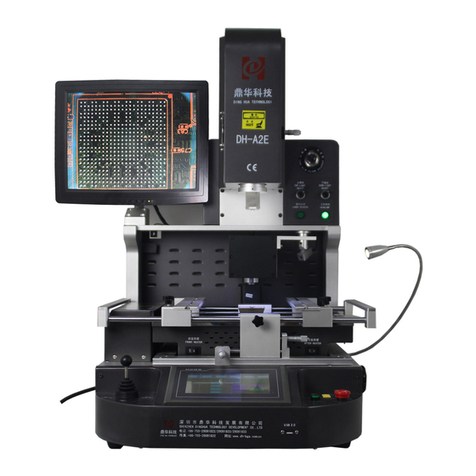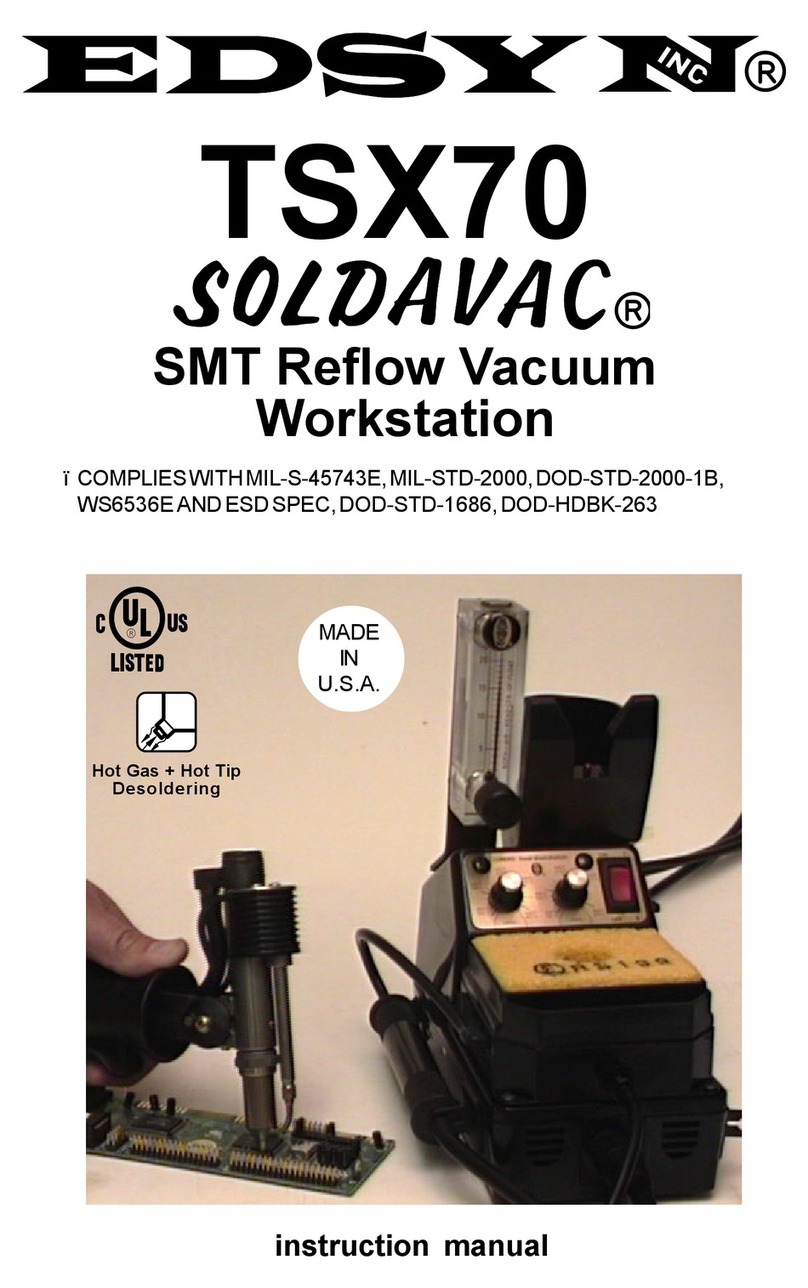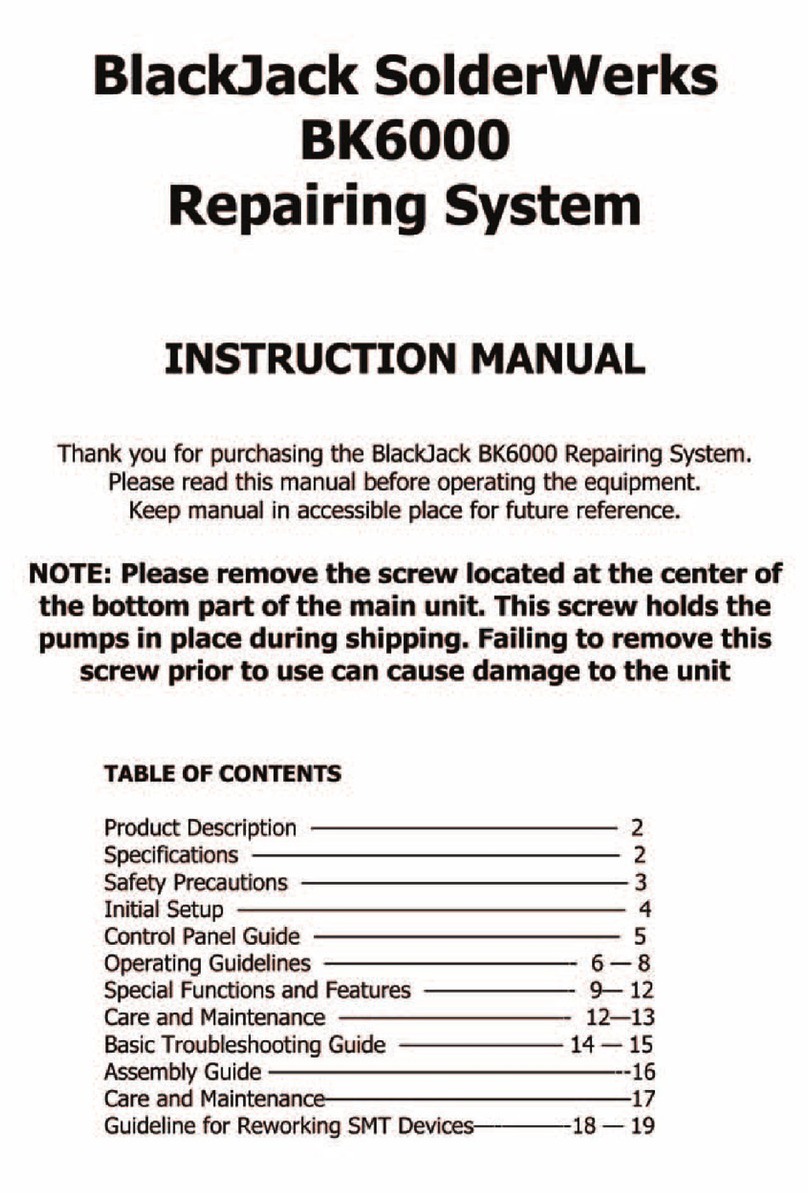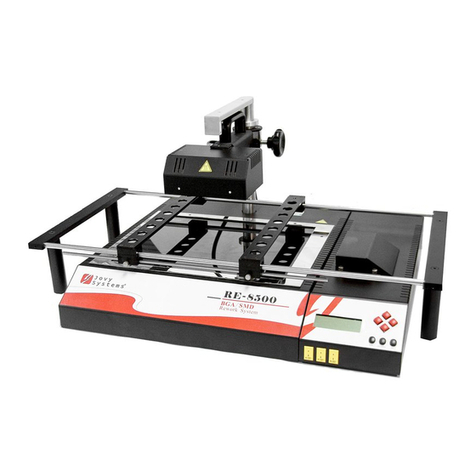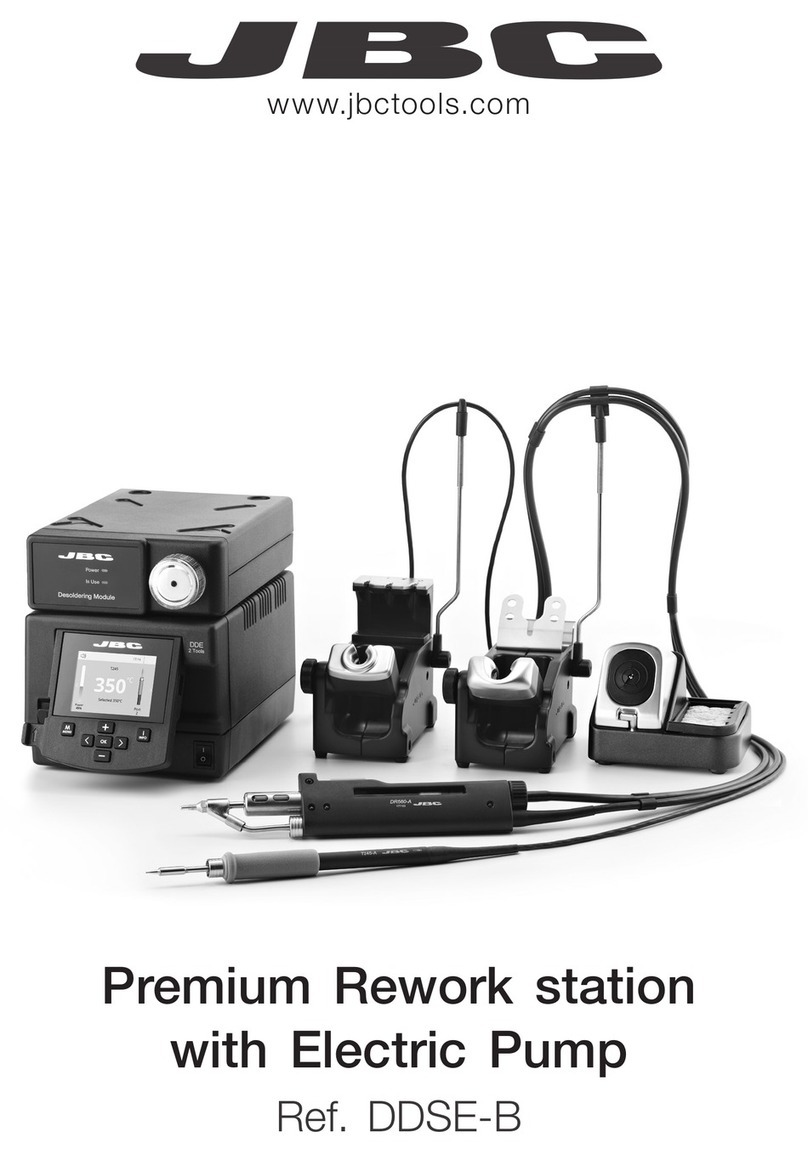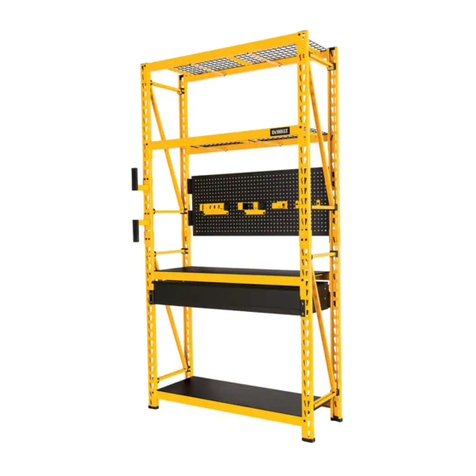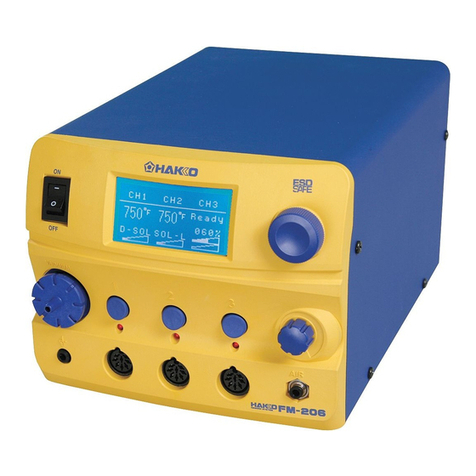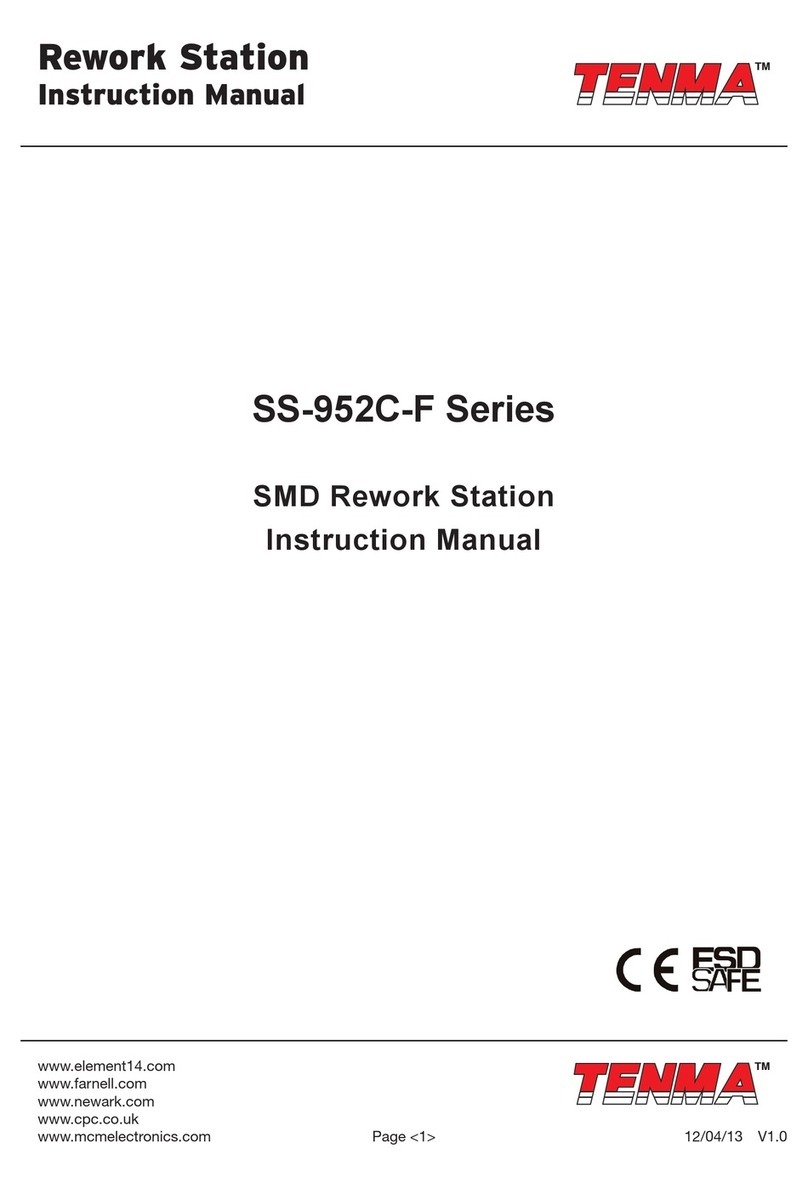Etneo BGA ETA-H15 User manual

BGA ETA-H15
BGA/SMD Rework Station
Operation Manual
Catalogue
1. Summary ...................................................................................................................................................1
2. Product Picture .......................................................................................................................................... 2
3. The unit is supplied with ........................................................................................................................... 2
4. Safety Instructions..................................................................................................................................... 2
5. Specifications and Technical Parameters................................................................................................... 3
5.1 Specifications .......................................................................................................................................... 3
5.2 Technical Parameters............................................................................................................................... 4
6. Install and Connect System ....................................................................................................................... 5
6.1 Place System............................................................................................................................................ 5
6.2 Install RPC...............................................................................................................................................5
6.3 System Connecting.................................................................................................................................. 5
7. control box Instructions.............................................................................................................................6
8. IR System Operation ................................................................................................................................. 7
8.1 Part Function ........................................................................................................................................... 7
8.2 Parameters Setting................................................................................................................................... 7
8.3 Operating technics instruction............................................................................................................... 15
9. PL System Operation............................................................................................................................... 17
9.1 Component function.............................................................................................................................. 17
9.2 Aligning Technics.................................................................................................................................. 18
10、Equipment Maintenance...................................................................................................................... 19
11、QSOFT brief instruction........................................................................................................................ 1
11.1 operation interface................................................................................................................................. 1
11.2 counterpoint operation interface............................................................................................................ 2
11.3 parameter testing interface..................................................................................................................... 3
11.4 curve analysis interface.......................................................................................................................... 4
11.5 advanced setting interface...................................................................................................................... 4


BGA ETA-H15 OPERATION MANUAL
Page1
1. Summary
Thank you for using BGA ETA-H15 Rework System. This system, which adopts micro-processor control
and infrared sensor technology to do soldering and de-soldering to surface mount components safely and
accurately, increases bottom heating power based on the original one. It can also control the whole technical
process and record all the information by means of the IR Software, thus meeting the higher technical
demands of modern electronic industry. It becomes one of the most valued electronic equipments in this field.
BGA ETA-H15 consists of two parts: IR ETA-H15 Infrared Rework System and PL ETA-H15 Precision
Placement System.
In order to control the soldering process optimally and get the nondestructive and reproductive PCB
temperature, IR ETA-H15’s heating power is up to 2400W, suitable for all applications, such as large or small
PCB as well as lead-free process. The technology of re-flow soldering controlled by closed-loop ensures the
precise and smaller technical window, even heat distribution and appropriate peak value of temperature for
lead-free soldering.
IR ETA-H15 Rework System adopts micro-processor control and infrared sensor technology. It has the
precision non-contact infrared temperature sensor for de-soldering parts and the middle wavelength infrared
heater. The soldering process is under the monitoring of non-contact infrared sensor and optimum control of
process can be achieved at any time. The middle-wavelength infrared heater has a well-proportioned and safe
heating and power and flexibleness necessary for the system, so it can also deal with some PCBs with big
thermal capacity and other high temperature situation (lead-free soldering) easily. The adjustable aperture
under the infrared heater can protect the adjacent components (which are sensitive to the temperature) on
PCB from being heated. No need for nozzles.
IR ETA-H15 works under the “open environment”, that is, it can calibrate and test temperature in
soldering process. When the melting of solder is found by visual inspection, press down the calibrating button
to record the melting temperature of solder. IR ETA-H15 has 10 types of working modes and programmable
temperature controlling can modify the parameters of every working modes. IR system and setting of
parameters are operated by outside Keyboard as well as by IR soft.
The use of reflow process camera provides the critical visual information for judging the melting of
solder during the whole soldering and desoldering process.
Besides, IR ETA-H15 can cool down the PCB efficiently. With the intelligent lead-free digital
calibrating soldering station, it is a integrated and perfect soldering equipment for any professional user.
PL ETA-H15 precision placement system provides precise alignment control for soldering process of IR
ETA-H15 rework system. The precision fine-adjustment and fine-alignment information provided by RPC
ensures the perfect soldering results. PL ETA-H15 uses a keyboard to control the operation. The outside
keyboards and IR ETA-H15 and RPC ETA-H15 make a whole set of BGA rework system which becomes a
higher-end equipment for reworking on electronic products.

BGA ETA-H15 OPERATION MANUAL
Page2
2. Product Picture
3. The unit is supplied with
Please check whether the following parts are included and intact.
* Main Unit BGA ETA-H15
* Control box
* IR Camera—RPC
* BGA ETA-H15 Operation Manual
* video line
* USB connect line
* video capture card
* BGAtool box
*computer LCD (optional)
4. Safety Instructions
Note: For safety of system and operator, please read this manual carefully before operating the unit.
Please note that the unit is suitable for soldering and de-soldering of electronic components.
Note: Top and bottom IR radiator will be very hot during working, so explosive and combustible object or
gas and solvent is strictly prohibited in working areas, also please don’ touch the hot housing parts

BGA ETA-H15 OPERATION MANUAL
Page3
Note: The laser alignment device includes a secondary laser device, so don’t see the laser bean directly.
Note: When the system happens trouble and needs maintenance, it should be carried on by a experienced
and authorized technician or expert, or contact with service agent and factory.
The unit with dangerous voltage! The inexperienced work is dangerous for operators.
5. Specifications and Technical Parameters
5.1 Specifications
IR System:
1.General Power: 2800W(max)
2.Power of Bottom Heater: 400W*4=1600W (Infrared ceramic heating tube)
3.Power of Top Heater: 120W*6=720W (Infrared heating tube, wavelength2~8µm,
size:60*60mm)
4.Preheating Time of Bottom Heater: about90s,size:260*260mm
5.Top heater range size: 20~60mm
6.Vacuum Pump: 12V/300mA, 0.05Mpa
7.Top cooling Fan: 24V/300mA 15CFM
8.Laser Alignment Tube: 5V/30mA 2pcs
9.LCD Display Screen: 65.7*23.5(mm)16*2 character
10.Communication: Standard USB connector (Connect with PC)
11.Movable Motor: stepping motor
12.MovableArm Range: 135mm
13.Infrared Temperature sensor: 0~300℃(Testing range)
14.Outside K Type Sensor 3pcs
15.Max PCB Size: 380mm*420mm
16.Fuse: 3pcs, 20A(220V)
PL System:
1.Power: about 15W
2.Camera: 12V/300mA;
Magnification: 22×10 times
Horizontal resolution: 480 TV lines
PAL format (composite)
3.Vacuum Pump: 12V/600mA 0.05Mpa (max)
4.LED lighting: yellow LED below lightblue LED up light(with adjustable brightness)
5.Movable Arm Range: 196mm
6.Movable Motor: stepping motor
7.Size 850*720*730(mm)
8.Camera output signal is video signal

BGA ETA-H15 OPERATION MANUAL
Page4
9.The operation of Camera on PL and IR alternates according to the movement of PL’s telescopic arm.
Brightness of IR camera is controlled by keyboard of PL.
Net weight:75kg
Packaging dimension:1050*800*880(mm)
5.2 Technical Parameters
TL:Melting temperature of solder
T1:Heat preservation starting temperature of reflow soldering
T2:Heat preservation ending temperature of reflow soldering
T3:Peak value temperature of soldering and de-soldering
T0:Valve temperature: The lowest temperature of Bottom Heater when Top Heater heats up. T0<TB
TIR:The set temperature of bottom heater
TB:The real-time temperature of bottom heater
TC:The real-time temperature of top heater
S1:Heating time rising from T1 to T2
S2:Heating time rising from T2 to T3
S3:Heat preservation time of T3
IR ETA-H15 Rework System has ten working modes and its parameter can be changed according to
demand. The following eight data can be referred.
0.T1=120℃S1=50s T2=140℃S2=45s T3=195℃S3=15s TL=183℃TB=150℃
T0=100℃
1.T1=130℃S1=40s T2=145℃S2=45s T3=200℃S3=15s TL=183℃TB=160℃
T0=150℃
2.T1=140℃S1=30s T2=150℃S2=50s T3=200℃S3=20s TL=183℃TB=160℃
T0=155℃
3.T1=140℃S1=40s T2=150℃S2=50s T3=195℃S3=25s TL=183℃TB=165℃
T0=160℃
4.T1=160℃S1=50s T2=180℃S2=40s T3=230℃S3=15s TL=217℃TB=170℃
T0=150℃
5.T1=160℃S1=40s T2=175℃S2=50s T3=225℃S3=20s TL=217℃TB=180℃
T0=170℃
6.T1=170℃S1=40s T2=185℃S2=50s T3=228℃S3=20s TL=217℃TB=180℃
T0=180℃
7.T1=180℃S1=40s T2=185℃S2=50s T3=228℃S3=25s TL=217℃TB=190℃
T0=185℃

BGA ETA-H15 OPERATION MANUAL
Page5
6. Install and Connect System
6.1 Place System
* Unwrap the packing of the unit, then take out BGA ETA-H15 Main Unit and put it on the horizontal
worktable.
6.2 Install RPC
1. Unscrew RPC Fixing Knob on the RPC Fixing Bracket and install RPC in the Bracket, tighten knob.
2. Put the plug of RPC connecting wire into Camera Socket.
3. RPC’s position can be adjusted. Unscrew fixing knob in corresponding direction and then adjust. RPC can
be moved up and down or turned.
6.3 System Connecting
* * Please check whether the supply voltage accords with the rated voltage on the system nameplate.
* Please check whether all switches are turned off.
* Connect the video cord of outside Indicator or Monitor to the VIDEO-OUT socket.
* Connect IR camera(RPC)to IR camera socket.
* Connect control box to socket.
* Connect ground line to ground hole.
After all above steps, insert power plug into power sockets, and turn on switch.
Install RPC herein.
RPC Fixing Knob
RPC Fixing Bracket
Camera
Socket
RPC (Reflow Process Camera)

BGA ETA-H15 OPERATION MANUAL
Page6
7. control box Instructions
IR system Key
A. During selecting working flow period, UP and DOWN knob are used for controlling the moving
upward or downward of cursor but when in standby interface, it can increase or decrease the digital.
During the soldering or de-soldering period, also top IR heater haven’t started to heat up, knob UP and
DOWN are used for controlling movement upward or downward of top IR heater. That is to say, during
movement upward and downward of top IR heater, after pressing the key start, UP and DOWN knob make
the top heater stop at a proper position.
B. Under the standby condition, if the cooling fan have already drawn back, press UP and DOWN knob to
make the top IR heater move up and down.
C. Function of OK key: Make the BGA-IR enter parameters setting mode and cursor move a step forward.
D. Function of “cool/stop” key: if BGA-IR in flow, stop and finish flow; if BGA-IR in flow, open or close
cool fan.
E. Function of “START” key: in standby state, make BGA-IR enter solder and desolder.
F. Function of “in-out/suck” key: cool fan stretch out or retraction.
PL system Key
G. Function of “Z” key: rotate it, can realize suck mouth movable.
H. Function of “R” key: rotate it, can realize clockwise or anticlockwise rotate, rotate degree have no limit.
I. Function of “ZOOM/IN-OUT” key: rotate it, adjust magnify ratio of picture, press it, control aligning
prism pass in and out.
J. Function of “FOCUS/SUCK” key: rotate it, realize focus; press it, suck chip.
K. Function of “BLUE” key: rotate it, adjust blue light of camera; press it, close the light.
Connect USB line
Connect video line
Connect control box
Connect ground line

BGA ETA-H15 OPERATION MANUAL
Page7
L. Function of “YELLOW” key: rotate it, adjust yellow light of camera; press it, close the light.
8. IR System Operation
8.1 Part Function
* Adjust the Aperture System
The Aperture System of Top Radiator can be adjust from 20×20 (mm) to 60×60 (mm) by two Adjustment
Knobs. Unscrew the knobs before adjusting, and adjust the window size, then tighten knobs. The scale “2” on
the housing means 20mm and “3’ means 30mm, other scale is similar. For example, if you want to adjust size
to 50×50(mm), adjust two knobs to the scale of “5” and tighten them.
Note:
Adjusting the aperture system can protect the adjacent components on the PCB from being heated. But, when
the aperture system is adjusted to small size, the Top Radiator will be very hot and decrease its lifetime, so
it’s necessary to increase the window size appropriately to avoid the damage of the Top Radiator.
8.2 Parameters Setting
Parameter settings order as the follows:
A._password: *** (Password settings)
B、_select: 0 (Flow settings, it can modify parameter inside).
C._type: solder (Working mode settings)
D._laser: off (Laser alignment settings)
E._baud: 19200 (Communication speed settings)
A. Input password
The initial password of system is “000”. At the same time, system also has the omnipotent password “159”. If
Scale
Adjustment knob

BGA ETA-H15 OPERATION MANUAL
Page8
you forget the setting password, you can input “159” to make the password of system come back to initial
password “000”.
Note: If want to modify any parameter system, you must input password, otherwise, you can only browse them.
For instance: Input the initial password “000” of system.
Press MENU Press MENU
rotate MENU Press MENU
旋转
rotate MENU Press MENU
rotate MENU Press OK
After input password:
1. If you want to modify the password, return to above mode to input the new password. If password is
modified successfully, it will show:
TC:022˙C Tb:019˙C
ready for flow
_password: ***
select: 0
password: ***
select: 0
password: 0**
select: 0
password: 0**
select: 0
password: 00*
select: 0
password: 00*
select: 0
password: 000
select: 0
Saving Password!
Any key return !
Saving Password!
Any key return

BGA ETA-H15 OPERATION MANUAL
Page9
2. 2.If you want to modify the next working flow, operate as the following B item; If you don’t want to
modify, please press DOWN knob to browse the following parameter settings.
B. Modify working flow
For instance: Modify the working flow and make it become 1 flow.
rotate MENU Press MENU
Step①Step②
rotate MENU Press OK
Step③Step④
1. When carry on the fourth step (Step④), if press “SET” key, you can browse and modify parameter of
this flow, shown as C-1 item.
2. After finishing modifying of working flow 1, if you want to modify the next working mode, operate as C
item shows; If you don’t want to modify it, you can press DOWN knob to browse the next parameter
settings.
C. Modify working mode
For instance: Modify the working mode and make it in “desolder” mode.
rotate MENU Press MENU
rotate MENU Press OK
password: ***
select: 0
password: ***
select: 0
password: ***
select: 0
password: ***
select: 1
password: ***
select: 1
password: ***
select: 1
select: 1
type: solder
select: 1
type: solder
select: 1
type: desolder

BGA ETA-H15 OPERATION MANUAL
Page10
After finishing modifying working mode, if you want to modify laser alignment mode, operate as D item
shows; if no need to modify it, please press DOWN key to browse the next parameter settings.
C-1. Modify Parameter of working flow
1. If it is necessary to modify parameter of a working flow, first you must select the working flow and then
modify its parameter.
The soldering technics is decided by T0, TB, T1, T2, T3, S1, S2 and S3. It describes the temperature graph
during the system working. TL denotes Melting temperature of solder and the range between T2 and T3.
T0
T0 is the valve temperature for bottom heater required by top heater when it heats up. Also it is the first
temperature of this technics process. When the work flow begins, the bottom heater starts to heat up. After
reaching the T0, the top heater begins to heat up.
TB TIR TC
TB: The test temperature of bottom preheating TIR: set temperature of bottom heating TC: Real-time
temperature of top heating
T1
It is the heat preservation starting temperature of reflow soldering. It is the second temperature of this
technics process. The temperature rises to T1 with a proper speed the component permits. In parameter
modifying, use the UP and DOWN knob to set the value of T1.
T2
It is the temperature when finish the heat preservation of reflow soldering. The pre-heating temperature rises
to T2, after the time of S1 finishes. Within this time, PCB and component pre-heating is finished and the
solder is activated. In parameter modifying, use the UP and DOWN key to set the value of T2.
T3
It is the peak value temperature of reflow soldering. When the temperature reaches T2, the temperature
equably rises to T3 with a definite raising speed. The soldering or de-soldering will be finished when the
temperature reaches to the peak value and performs the next step. In parameter modifying, use the UP and
DOWN key to set the value of T3.
TL
select: 1
type: desolder

BGA ETA-H15 OPERATION MANUAL
Page11
Melting temperature of solder. At this temperature, the solder starts to melt down and turn into liquid.
S1
Heating time rising from T1 to T2. User can set the value in the range of 0~300s.
S2
Heating time rising from T2 to T3. User can set the value in the range of 0~300s.
S3
Prolonged heating time (Heat preservation time) after the temperature reach T3, and user can also set the
value in the range of 0~999s.
Unit
It’s able to set the unit of display temperature during work flow. In parameter modifying, use UP and DOWN
keys to set the value of it.
Sensor
It is used for choosing the system’s sensor type. Users can also choose K type sensor used for measuring
temperature, besides system’s IR sensor. The signal of chosen sensor will be displayed and used for process
controlling. In parameter modifying, use the UP and DOWN key to set the value.
Password
It is used for setting password. It is designed for preventing the equipment unnecessary or non-authorized
change. When it is set to “000”, the password protecting is useless. The password is used for all flows and it
can be useful and useless in each flow. The system requires inputting correct password before any change.
Using of password refer to Aitem.
For instance: Modify parameter of flow one and make T1=130℃, S1=70s, T2=160℃, S2=50s,
TB=130℃. (Flow one has been selected)
Press MENU Press MENU
Press MENU rotate MENU
Press OK rotate MENU
password: ***
select: 1
_T1: 110℃
S1: 060s
T1: 110℃
S1: 060s
T1: 110℃
S1: 060s
T1: 130℃
S1: 060s
_T1: 130℃
S1: 060s

BGA ETA-H15 OPERATION MANUAL
Page12
Press MENU Press MENU
rotate MENU Press OK
rotate MENU Press MENU
Press MENU rotate MENU
Press OK Press MENU
Press MENU Press MENU
T1: 130℃
_S1: 060s
T1: 130℃
S1: 060s
S1: 070s
T2: 150℃
S1: 070s
T2: 150℃
S1: 060s
T2: 150℃
S1: 060s
T2: 160℃
T1: 130℃
S1: 060s
T1: 130℃
S1: 070s
T1: 130℃
S1: 070s
S1: 060s
T2: 160℃
T2: 160℃
S2: 030s
T2: 160℃
S2: 030s
T2: 160℃
S2: 030s
T2: 160℃
S2: 050s

BGA ETA-H15 OPERATION MANUAL
Page13
rotate MENU Press OK
rotate MENU rotate MENU
rotate MENU rotate MENU
Press MENU Press MENU
按下 MENU
rotate MENU Press OK
rotate MENU rotate MENU
rotate MENU Press OK
TL: 183℃
TB: 140℃
T0: 090℃
T FAN:100S
T FAN:100S
SPD: 80
T2: 160℃
S2: 050s
S2: 050s
T3: 200℃
T3: 200℃
S3: 010s
S3: 010s
TL: 183℃
TL: 183℃
TB: 140℃
TL: 183℃
TB: 140℃
TL: 183℃
TB: 130℃
TL: 183℃
TB: 130℃
TB: 130℃
T0: 090℃
TC:022˙C Tb:019˙C
ready for flow

BGA ETA-H15 OPERATION MANUAL
Page14
D. Modify laser alignment mode
For instance: Modify the laser alignment mode and set it to “on”.
rotate MENU Press MENU
rotate MENU Press OK
1. After finishing the modification, the next step communication speed, will not be able modified by
keyboard.
2. Press OK key to exit. Now, the system has saved all parameter settings, IR window will display:
3. After all technics parameters have been selected, press BEGIN key and the system perform the set flow.
E. System Error Indication
1. In initial state, if the top sensor or outer sensor is broken, it displays:
If the bottom sensor is broken, it displays:
select: 1
type: desolder
type: desolder
laser: off
type: desolder
laser: off
type: desolder
laser: on
type: desolder
laser: on
TC:022℃Tb:019℃
ready for flow
TC: ***℃Tb: ***℃
T sense error !
TC: ***℃Tb: ***℃
B sense error !

BGA ETA-H15 OPERATION MANUAL
Page15
If above status happens, user should stop operating.
2. During the upward or downward movement of Top Heater or holding out and drawing back of fan arm, if
it doesn’t reach over 10 seconds, the unit will come back to initial state all and singular in spite of what
state it is here. It displays:
3. When TC is less than 180℃during working, if the rising temperature is less than 7℃, and the system
will exit the process and display “TC raise error”.
4. If TC is over than 265℃ during working, the system will exit the process and display “TC over error”.
8.3 Operating technics instruction
Note: Top and Bottom Heater will be very hot during working, so please don’ touch the hot housing parts.
Note: The laser alignment device includes a secondary laser device, so don’t see the laser bean directly.
8.3.1Soldering Technics
1. Turn on power switch of each part.
2. Move PCB Fixture with fixed PCB and make it above the Bottom Radiator and make the soldered
component on the PCB between Top Radiator and Bottom Radiator. The position is easy to be measured
with laser alignment device. The right position should make the red laser point in the center of
component.
3. Adjust aperture system, and get a proper window size.
4. Adjust RPC in appropriate place, adjust size and focus of image with PL keyboard to display component
image in the monitor clearly.
5. Select parameter with keyboard. (Refer to Parameters setting)
A. Input password ”000”
TC: ***℃Tb: ***℃
Move error!

BGA ETA-H15 OPERATION MANUAL
Page16
B. Select the required flow, if need to modify, perform relevant operation.
C. Select “solder” working mode.
D. Select “IR” laser alignment mode.
E. No change to communication speed, and press EXIT key to exit. IR window shows:
F. Press “START”key ,and the system start working, perform content of selected flow.
6. IR window will display series of setting temperatures and the current temperature of Tb and TC during
working, and indicate when it reaches T0, T1, T2, T3 and TL. S1, S2 and S3 are counted down and user
can know about the setting value clearly.
7. If you see the solder has melted down (It is watched with RPC and Monitor), you can press CAL key to
calibrate temperature of TL to adjust the display temperature to liquid temperature TL.
8. When the temperature reaches TL, there will be a voice signal.
9. When the temperature reaches T3, the sound signal changes to a briefness sound and the system delays
heating by S3 seconds. After that, the system will not heat up anymore and exit the process automatically,
the technical process is over.
10. The system can perform a series of function action during working.
A. After press START key, the top heater move downwards near to bottom.
B. After the system sounds unvaryingly, the top heater move upwards and Top Cooling Fan and
Outside Cooling Fan spread out to blow cooling air simultaneously.
C. After 150 seconds, the two Cooling Fns stop blowing, and the soldering technics has been finished.
8.3.2 De-soldering Technics
1. Turn on power switch of each part.
2. Fix the PCB on the top of Bottom Heater and make the de-soldered component between Top Heater and
Bottom Heater. The position is easy to be measured with laser alignment device. The right position
should make the red laser point in the center of component and the suction pad in center of component
also.
3. Press the vacuum suction tube to check whether suction pad is in the center of component. (If the
deflection is too much, the tube will not be able to pick up the component.
4. Adjust aperture system, and get a proper window size.
5. Adjust RPC in appropriate place, adjust size and focus of image with PL keyboard to display component
image in the monitor clearly.
6. Select parameter with keyboard. (Refer to Parameters setting)
A. Input password ”000”
B. Select the required flow, if need to modify, perform relevant operation.
C. Select “desolder” working mode.
D. Select “IR” laser alignment mode.
E. No change to communication speed, and press OK key to exit. IR window shows:
TC:022˙C Tb:019˙C
ready for flow
TC:022˙C Tb:019˙C
ready for flow

BGA ETA-H15 OPERATION MANUAL
Page17
F. Press START key and the system start working, perform content of selected flow.
7. After pressing START key, Bottom Heater starts to heat up and Top Heater moves downwards and reach
to bottom.
8. IR window will show a series of setting temperatures during working. Indicate when it reaches T0, T1,
T2, T3 and TL. When the bottom temperature reaches T0, the top heater begins to heat up.
9. When the temperature reaches TL, it will give a sound alert automatically (Low frequency).
10. When the temperature reaches T3, it will also give a sound alert automatically. (Middle frequency)
11. When the solder has melted down, press the vacuum suction tube to pick up the component.
12. Press the vacuum suction tube, the vacuum pump start to work and pick up component, then return to
original position. The system stops heating.
13. The Top Heater moves upwards and stops at top.
14. Top Cooling fan and Outside Cooling Fan spreads out to blow cooling air simultaneously.
15. 90 seconds after the top heater starts moving upwards, the vacuum suction tube looses component
automatically.
16. After the two Cooling Fans blow cooling air for 150 seconds, the whole de-soldering process will be
over.
9. PL System Operation
9.1 Component function
1. Crosswise Cooling Fan
Besides the existing top cooling system, the system adds outside Cooling Fan again to speed up the cooling
process of PCB.
2、PCB fixture
* The movable PCB fixture is able to fix PCBs of different sizes. It has four Fixing Knobs and two
Micro-adjustment Knobs. Two PCB Fixing Knobs are used for locking PCB Clamp Bar to fix PCB. The
other two Fixture Fixing Knobs are used for locking the PCB Fixture to prevent it from moving
lengthways and transverse. The two Micro-adjustment Knobs are used for adjusting accurately while
aligning the component.
* Unscrew PCB Fixing Knobs and move the Slide Block to open the PCB Clamp Bar, make the distance in
accordance with PCB size. Fix PCB between Clamp Bars and screw down PCB Fixing Knob after

BGA ETA-H15 OPERATION MANUAL
Page18
adjusting position. If you want to lock PCB Fixture, please screw down Fixture Fixed Knob.
* When the component is aligned accurately, screw down Fixture Fixing Knobs first and then adjust
accurately. Turn “PL Micro-adjustment knob1 to make PCB Fixture move right and left for adjusting
PCB’s right and left position. Turn it clockwise for rightwards move and turn it anticlockwise for leftwards
move. Turn “PL Micro-adjustment knob2 to make PCB Fixture move forward and backward for adjusting
PCB’s front and rear position. Turn it clockwise for forward move and turn it anticlockwise for move
backward.
4.RPC (Reflow Process Camera)
RPC’s position can be adjusted. First, unscrew Fixed Knob in corresponding direction and then adjust. RPC
can be moved up and down or turned.
5.PL Camera
* It needs to use PL camera during the component aligning. PL camera will transmit the image of soldering
point on PCB and component pins under nozzle to Display or Monitor through video signal and user can
see these images on Display or Monitor. At the moment, you can use each adjusting function to align
component.
* It needs to completely pull out PL camera when using it. At this time, the image displayed is got by PL
camera. When not in use, push it back, and the image displayed is got by IR camera.
9.2 Aligning Technics
1.Place the soldered component in jig, move PCB Fixture to make the vacuum pen aim at component on
the jig. Turn the Nozzle Controlling Knob to make nozzle move down to pick up component. The
Fixed Knob
X axis PL Micro-adjustment knob
Slide Block
PCB Fixed Knob
PL Camera
Table of contents
